Build your customer referral program without the dev time
Sign up for a free trial of GrowSurf to lower your customer acquisition costs, increase customer loyalty, and save gobs of time.
Launch Your ProgramSaaS (Software-as-a-Service) businesses have seen explosive growth in recent years as more companies move operations to the cloud. According to Gartner research, companies worldwide spent a whopping $145 billion in 2022 on cloud application services, a 23% increase from the previous year. This rapid growth highlights the immense opportunity for SaaS companies to capitalize on the rising demand for cloud-based solutions.
But SaaS companies face more challenges than ever, namely building brand awareness, establishing credibility and trust, and acquiring customers — all of which aren't easy in today's highly competitive market. With so many SaaS options available, it's crucial for companies to differentiate themselves and effectively communicate their unique value proposition to stand out.
So how can you reach and engage more of your target audience? How can you effectively demonstrate the value that your SaaS products deliver, establish thought leadership in your industry, and ultimately generate more revenue?
This is where a well-planned and executed social media marketing strategy comes in. By leveraging the right social media channels and tactics, SaaS companies can effectively reach and engage their target audience, build brand awareness and credibility, and drive growth.
This article will cover the key benefits of using social media to market your SaaS business, as well as provide actionable strategies and tactics that you can implement to increase your reach, engage your target audience, establish thought leadership, and ultimately attract more customers and drive growth.
Let’s start with a definition — social media marketing is all about using social platforms like Facebook, Twitter, and Instagram to build your brand. The goal is to reach your audience and promote your products or services.
If you’re not already using social media, you’re missing out on opportunities to grow your SaaS business.
Let’s take a closer look at the benefits of social media marketing.
With an estimated 4.2 billion social media users worldwide — well over half the global population — social media platforms offer an unparalleled opportunity for SaaS companies to increase brand awareness and reach a vast, highly targeted audience. As more people turn to social media to obtain information, connect with brands, and make purchasing decisions, the potential for SaaS companies to leverage these platforms for growth is immense.
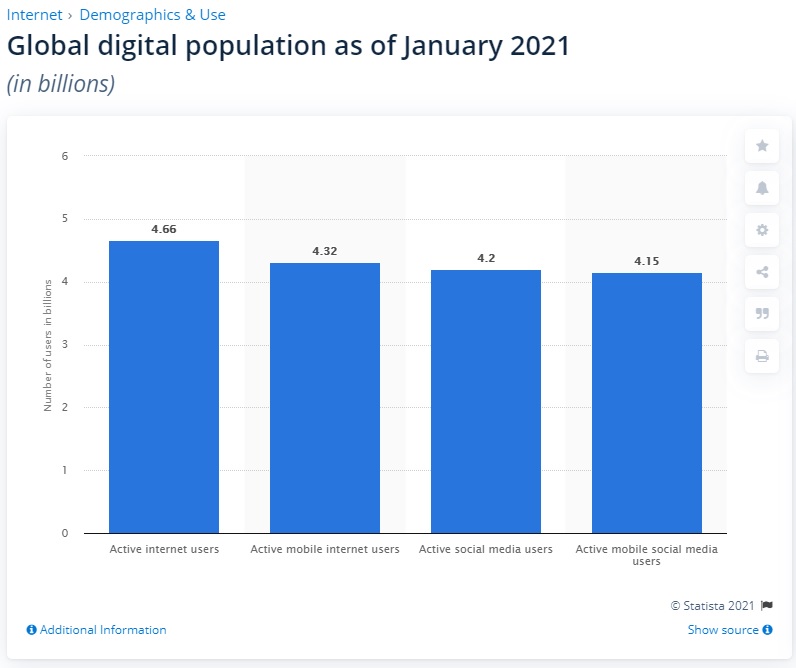
Image Source: Statista
With so many social media users, there’s a good chance your audience is on platforms like Facebook, Instagram, and Twitter.
A strong social media presence makes it easier for more people to discover and engage with your brand. Social is an important piece of digital PRand becomes more important as digital communities grow.
The buyer’s journey is more complex than ever. The average B2B buyer consumes 13 pieces of content before making a buying decision. Buyers not only source content directly through a potential vendor’s website but also turn to social media as well.
Content has a clear impact on the buyer’s journey.
Sharing quality content keeps you top of mind, helping your SaaS business generate more sales when prospects are ready to buy.
Track-POD, a route planner, regularly shares useful content on its Facebook page:
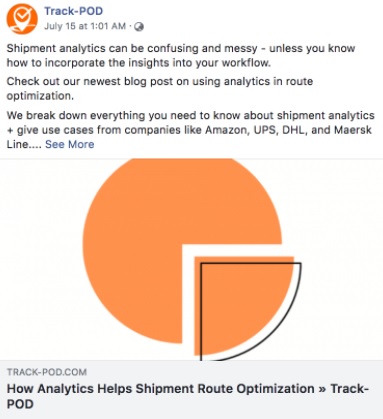
In today's digital age, more people are turning to social media to voice their opinions, share experiences, and engage with brands. As such, social media has become a crucial platform for SaaS companies to manage their brand reputation, address customer concerns, and foster strong customer relationships.
Failing to respond quickly and address customer concerns can leave customers with a negative impression, damage brand reputation, and potentially turn into a larger issue. By actively monitoring and engaging with customers on social media, SaaS companies can promptly address any issues, gather valuable feedback, and demonstrate their commitment to customer satisfaction.
Here’s an example of how Delta Air Lines helped one customer on Twitter:

Image Source: @Delta
According to Zendesk research, 75% of customers are willing to spend more on companies that offer great customer experiences. This underscores the importance of not only providing excellent customer service but also effectively presenting your brand and engaging with customers on social media platforms. By consistently delivering positive experiences and promptly addressing concerns, SaaS companies can foster customer loyalty, increase customer lifetime value, and drive growth.
Understanding your target audience is essential to driving growth and creating effective marketing campaigns that resonate with their needs and pain points. Social media platforms offer a wealth of data and insights that can help SaaS companies better understand their audience, including their demographics, interests, behaviors, and preferences.
Additionally, social media provides a valuable opportunity to monitor competitors, track industry trends, and gather competitive intelligence that can inform your product development and marketing strategies.
Platforms like Facebook and Twitter offer detailed analytics information about people who engage with your brand, including their demographics, interests, and behaviors. These insights can help you create more engaging and targeted content that resonates with your audience, as well as inform your overall marketing strategy and product development roadmap.
Furthermore, by monitoring social media conversations and engaging with your audience, you can gather valuable qualitative feedback and insights that can complement the quantitative data from analytics tools.
Social media isn't just a direct line to your customers; it also provides a valuable opportunity to monitor your competition and stay up-to-date on industry trends. By tracking mentions, conversations, and engagement around your competitors, you can gain insights into their marketing strategies, product offerings, and customer sentiment.
Additionally, monitoring industry-related hashtags, groups, and influencers can help you stay informed about emerging trends, new technologies, and shifts in customer preferences, enabling you to adapt your strategies accordingly and maintain a competitive edge.
For example, if you notice customers frequently complaining about a particular feature (or lack thereof) in a competitor's product, you can leverage that insight to highlight how your SaaS offering addresses that pain point in a targeted marketing campaign. This can help you differentiate your product and attract customers who are dissatisfied with the competition.
It's a marketing channel you can't afford to ignore, as it allows you to build brand awareness, engage your target audience, establish thought leadership, gather valuable insights, monitor competitors and industry trends, and ultimately generate more sales and drive growth for your SaaS business.
By leveraging the power of social media marketing and implementing a well-planned strategy, SaaS companies can effectively overcome the unique challenges they face and position themselves for long-term success in today's highly competitive market.
To help you effectively leverage social media for your SaaS business, let's explore some actionable tips and strategies that you can implement to grow your brand, engage your audience, and drive measurable results.
Sign up for a free trial of GrowSurf to lower your customer acquisition costs, increase customer loyalty, and save gobs of time.

As social media has evolved, so too have the responsibilities and workload involved in managing an effective social media presence. It's no longer just about posting content to your profiles; it also involves monitoring brand mentions, engaging with prospects and customers, collaborating with influencers, analyzing metrics with the help of social media analytics tools, and more. This breadth of tasks is far too much for any one person to handle effectively.
To ensure a cohesive and successful social media strategy, it's crucial to assemble a dedicated team with clearly defined roles and responsibilities. This team should work closely together to align social media efforts with your overall marketing and business objectives.
To build an effective social media team, companies are now expanding their recruitment efforts to find talented individuals with specialized social media experience and expertise. This includes roles such as social media managers, content creators, community managers, paid advertising specialists, and data analysts, each with their own unique responsibilities.
The first step to effectively leveraging social media for your SaaS business is to build the right team. Start by setting a dedicated social media budget, as this will influence your hiring decisions and the resources you can allocate. The size of your budget will depend on factors such as your specific goals, company size, annual revenues, and the level of investment you're willing to make in social media marketing.
While the specific roles and team structure may vary based on your budget and needs, there are a few key positions that are essential for an effective social media team:
Your social media team is your brand voice. Make sure to hire people who have the right experience and align with your company values and culture. If your budget is tight, consider working with freelancers and make plans to eventually expand your team.
New social networks continue to regularly make their way into the social sphere — each promising innovative ways to connect with people. For businesses, that means more opportunities to build brand awareness and generate more sales.
It can be tempting to join as many of these networks as possible, but you’ll only spread your efforts thin. This can dampen your social media marketing efforts.
With social media, it’s better to focus on quality than quantity. Ask these questions to identify the right channels to target:
Don’t forget about your audience’s demographics. Start with your current customer base and look through your Google Analytics data to gather this information. Then narrow down your choices to just a handful of platforms.
Imagine you discover a new brand while browsing Facebook. Its posts are witty and full of humor. But then you click through to its site, and the content doesn’t have the same tone. This can be jarring and leave you with a negative impression.
Establish clear guidelines to ensure your messaging is on-brand.
What tone do you want your content to reflect? If you’re a B2B SaaS company, you might opt for a professional tone. Brand guidelines are helpful resources that your team can refer to whether they’re creating a blog post or writing a tweet.
Don’t forget about visuals. You’ll want to use the same colors and images on every platform. As an example, Breadcrumbs, a revenue acceleration platform, maintains the same distinct comic design across each of its pages.
Here’s what their website looks like:
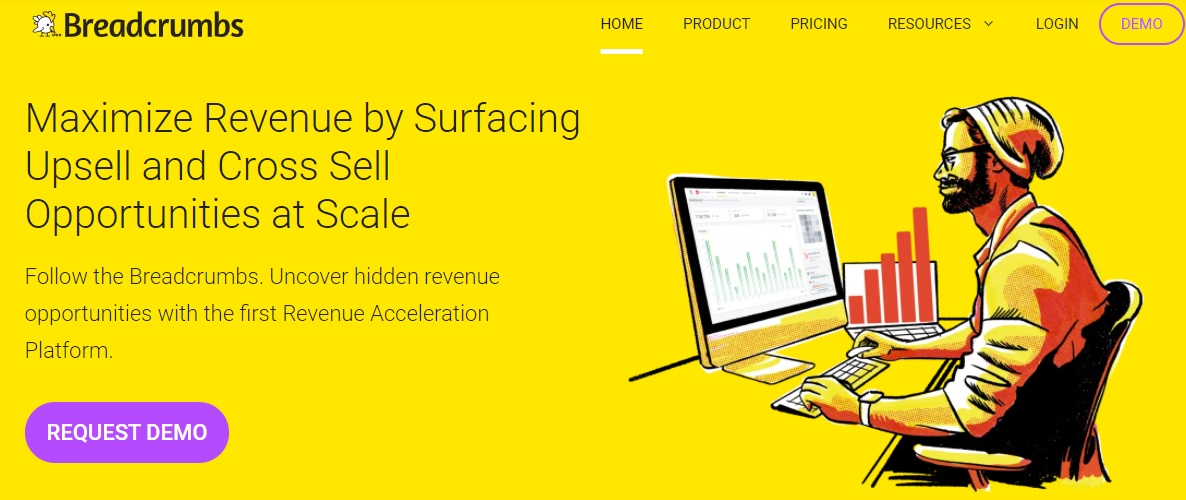
Here’s what their Twitter profile looks like:
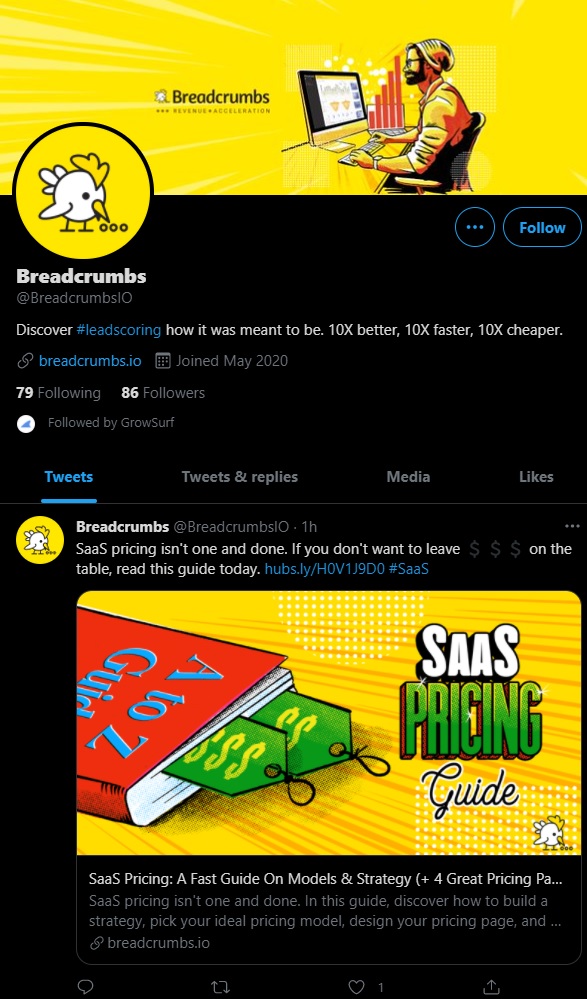
Visitors on Breadcrumb’s Twitter can instantly recognize the brand. Make sure to maintain a consistent voice and visuals across your channels. This can help you stand out from the competition and get more prospects interested in your SaaS business.
Most brands use social media to post and share their content. There’s nothing wrong with this approach, but it tends to be one-sided.
To drive measurable results and increase your reach, find ways to involve your audience.
For example, Trello ran a campaign on Twitter called #WhereITrello, inviting customers to share photos of where they use the platform.
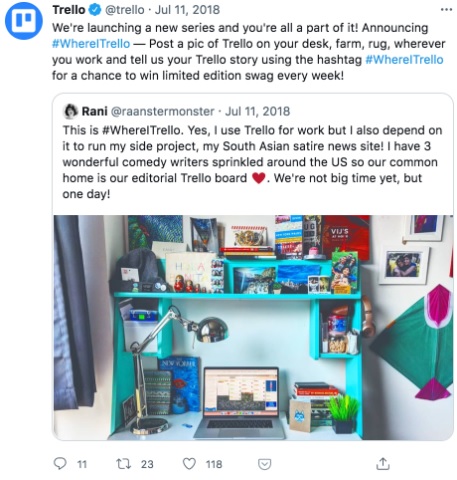
Involving your audience also allows you to gather user-generated content (UGC). As the name implies, it’s content that your users create. This type of content lends more credibility to your brand through word-of-mouth marketingand can influence purchasing decisions.
Capturing the attention of your audience on social media isn’t easy.
Fail to generate interest, and most users will scroll past your content without a second thought.
One way to increase engagement and generate more views is with quality visuals. A report from HubSpot on Instagram Stories found that users were more likely to tap through to the end of stories that contained photos, videos, and text.
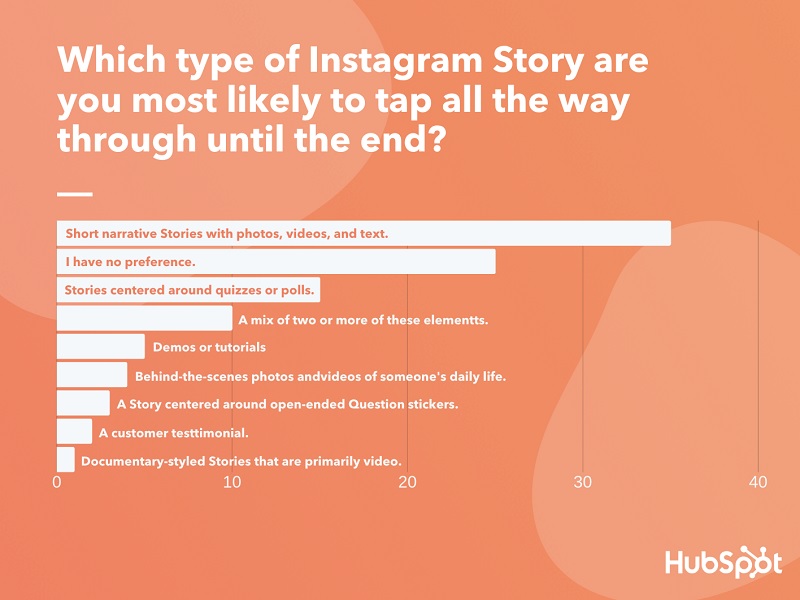
Image Source: HubSpot
If you’re not already adding images or videos in your posts, you’re likely missing out on a ton of views and engagement. Use image editing tools like Cava and Piktochart to create engaging visuals and infographics or you can use ClipChamp for creating video content.
Even if you have a post on a “boring” topic, you should still include images. For example, the topics of savings, custodial accounts, and investing aren’t the most entertaining.
But look at how Earlybird maintains a cheerful and fun Instagram presence around monetary gifts for children. The company does this through a combination of short videos, funny posts, and more serious ones that describe its services.
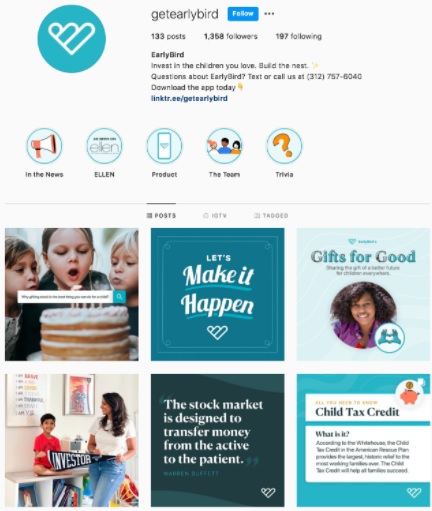
Find other ways to turn your content into engaging visuals. For example, you can easily turn interesting data about your SaaS business into an infographic.
Don’t stop at images and videos. Considering the global reach of podcasts, you can also promote your podcast through various social media channels to spread the word.
People have preferences regarding how they consume content. Using different formats helps your posts stand out and allows you to reach an even wider audience.
Running a giveaway is another great way to promote your SaaS business.
The way it works is straightforward. You announce a prize (e.g., an annual subscription) on a network like Facebook or Instagram and set entry criteria. Then you accept entries and announce a winner once the contest is over.
Here’s an example of a giveaway that Shea Moisture ran on Instagram for its beauty products:

The example above was for an eCommerce company, but you can just as easily run Instagram giveaways for your SaaS business.
Whether you’re running a giveaway on Facebook or Instagram, make sure that you follow the rules for each platform, or you risk legal action.
Instagram requires that you include eligibility requirements and acknowledge that Instagram doesn’t sponsor or endorse your giveaway. You also can’t tag users who aren’t in the post or encourage others to tag themselves if they’re not in the photo.
Seeing a commercial might not be enough to compel you to make a purchase. That’s because advertising from brands is the least trusted source of information among consumers. But if a friend or family member recommends a product, you’re more likely to pay attention.
93%of respondents in one survey trust friends and family as a source about brands.
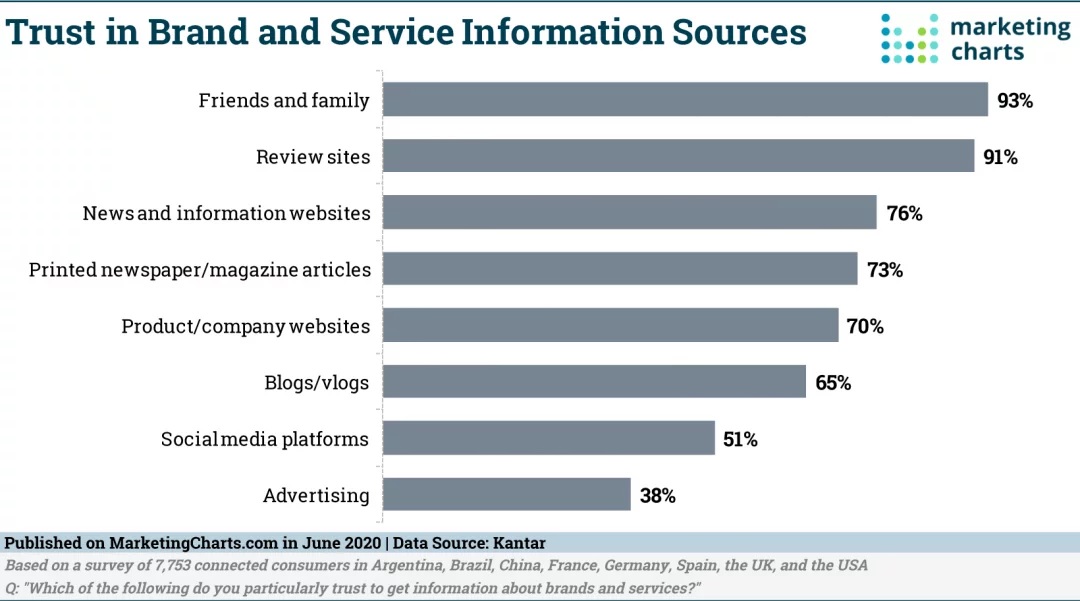
Image Source: Marketing Charts
Your customers are your best brand advocates. Getting referrals from them can lend more credibility to your SaaS business and generate more sales.
To illustrate how effective customer referrals are, 24 Hour Fitness generated over 330,000 referrals by allowing its members to send personalized guest passes to friends.
The easiest way to get customer referrals is to ask. If someone posts on your page about a great experience they had with your company, take the opportunity to respond and ask for a referral in a direct message.
To ramp up your efforts, you can also use referral software to give your customers their own referral link and issue rewards.
Social media has become an invaluable tool for businesses of all sizes to increase reach and grow customer bases. If you’re not already leveraging social networks like Facebook or Instagram to promote your SaaS business, it’s not too late.
Here are the main takeaways from this article to get you on the right track:
Boost customer referrals
Just remember that social media marketing is an ongoing process. You need to put in consistent effort to generate measurable results. It’s a lot of work, but it can help your SaaS business grow.

Sign up for a free trial of GrowSurf to lower your customer acquisition costs, increase customer loyalty, and save gobs of time.
Launch Your Program
GrowSurf is modern referral program software that helps product and marketing teams launch an in-product customer referral program in days, not weeks. Start your free trial today.
SaaS referral programs are one of the most cost-efficient ways for startups to gain new signups and paying customers. Here's 5 reasons why and examples to study
Word of mouth marketing can be the strategy that skyrockets your business and takes it to another level. Here we tell you all you need to know about it.
Your SaaS solution may be the best thing since sliced bread. You know deep in your gut it can make the lives of your target audience significantly better. But if you’re not generating enough leads, chances are your SaaS business won’t stick around for long. So, in this blog post, we’ll take a look into 12 stupidly, simple ways that can help you generate more SaaS leads for your business.